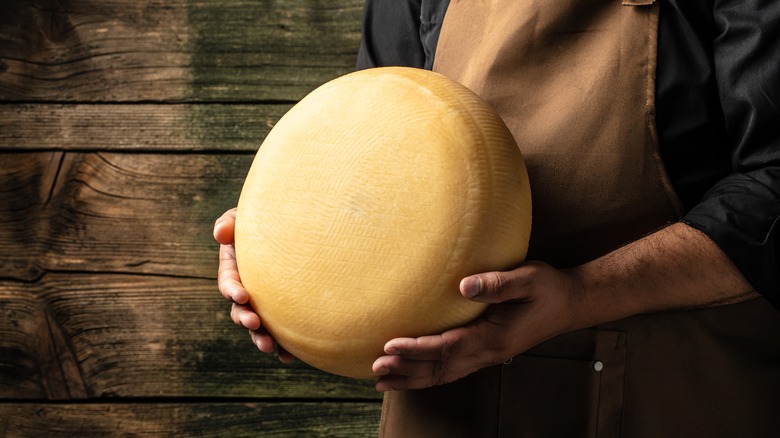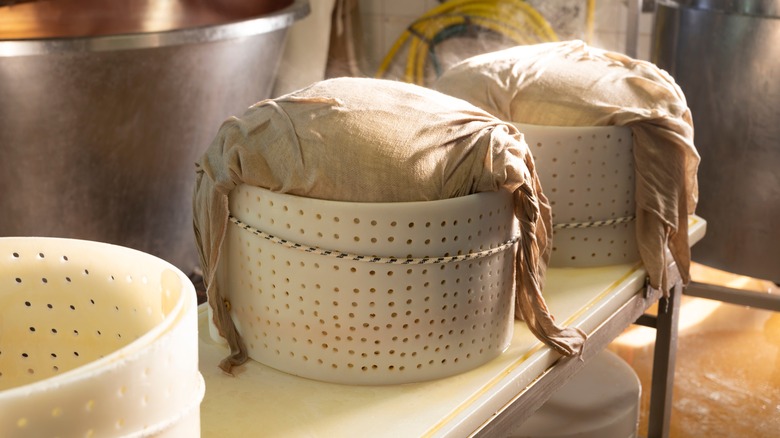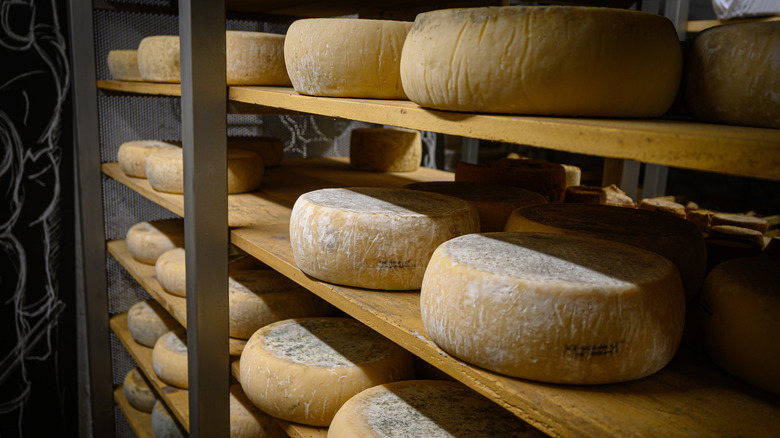The Science Behind Why Cheese Is Created In A Wheel Form
Food is an art form in and of itself, but some cheesemakers take it to the next level by sculpting their creations into unique shapes. Queso Oaxaca comes in braids, Caciocavallo looks like a Russian doll with a pointy hat, and there's even a heart-shaped cheese that's cheekily named "Fromage a Trois" (via Culture). Some go all-in on the novelty route, like Renard's Artisan Cheese of Wisconsin, which produces cheddar shaped like footballs, cows, beer mugs, and even the state of Wisconsin itself. One particularly noteworthy cheese is the French Valencay, which is molded into a flat-topped pyramid. According to a legend shared by Murray's Cheese of New York, Valencay was originally shaped like a normal pyramid until Napoleon, embarrassed by his military failures in Egypt, ordered the peak removed.
All of the above make for memorable additions to your cheese plate, but if we're being honest, you're far more likely to come across cheese in wheel form. Actually most cheese is sold in wedges cut from wheels rather than the whole thing. A full wheel of cheese is a major indulgence, and we're not talking about dairy fat. A wheel of Parmigiano Reggiano costs nearly $3,000 at Williams Sonoma, and at 80 pounds, you'd better be hungry for it. Even at Walmart, known for bargain prices, a 10-pound wheel of Dutch Gouda will set you back $115. But how did the wheel become the rule, and all other cheese shapes the exception? There are a few good reasons.
A round shape is practical
Archaeological evidence suggests that cheese has come in a round shape since the very beginning. According to Culture, cheese was likely invented by accident in southwest Asia, where the warm climate would have naturally caused milk to coagulate into curds and whey. Analysis of pottery dating back to 7,000 B.C. shows that early cheeses were made from milk stored in round ceramic vessels, making them naturally circular. As crazy as it might sound, these roughly wheel-shaped cheeses may have predated the wheel itself, which according to Smithsonian Magazine was not invented until around 3,500 B.C. (originally for use in pottery, by the way, not transportation). Of course, this was a result of incidental circumstances rather than intentional action on the part of cheesemakers.
As the history of cheesemaking progressed, people continued using the wheel shape, but for practical reasons. Mental Floss notes that wheel-shaped molds are sturdier than rectangular molds, which have seams that can easily split apart. This is an important point because the traditional process of making rind-covered cheese requires dry-salting over a long period before the curd sticks together. During this time, a strong mold is required to hold the cheese curds together under pressure. Furthermore, the wheel shape was practical for cheesemongers because it made it easy to transport their products. Rather than carrying a heavy block of cheese to the marketplace, they could simply roll it along.
The wheel serves a microbial purpose
Modern cheesemakers have recognized an important scientific value to the wheel shape. As Mental Floss explains, cheese ripens as it ages because it gradually absorbs salt and molds such as P. camemberti (notice how the name connects to camembert cheese). Mold may not sound like the most appealing thing, but it is essential for cheesemaking because it breaks down the proteins in milk. Making cheese in the shape of a wheel ensures that the mold can evenly spread across the surface and break down the milk proteins at an even rate. Culture notes that rectangles and other angular shapes pose a problem for cheese makers because when microbes collect on the corners, they attack the cheese from multiple angles, causing the edges to break down far too quickly. This can actually lead to spoilage.
Culture explains that the mold issue is most prevalent in soft cheeses that have a high moisture content, but the wheel form is also advantageous to hard, dry cheeses. Low-moisture cheeses were particularly valuable in ancient times because they could withstand long journeys from dairy farms to marketplaces. They could also last much longer in storage, something vital in the days before refrigeration. A large, flat wheel is ideal for low-moisture cheese because it has no creases or corners, meaning there's nowhere for moisture to build up. A big disk creates lots of surface area, which allows the moisture in the cheese to evaporate quickly and evenly.


